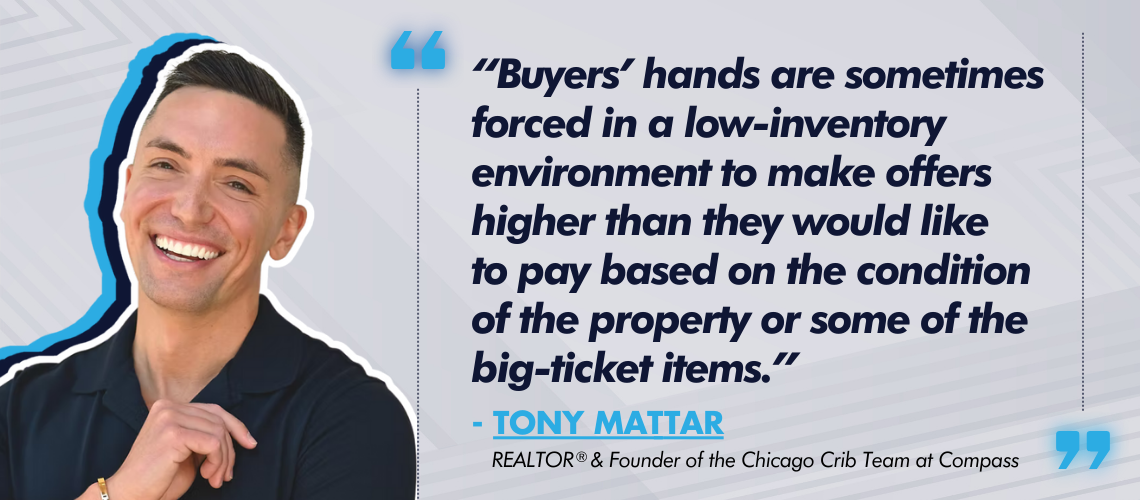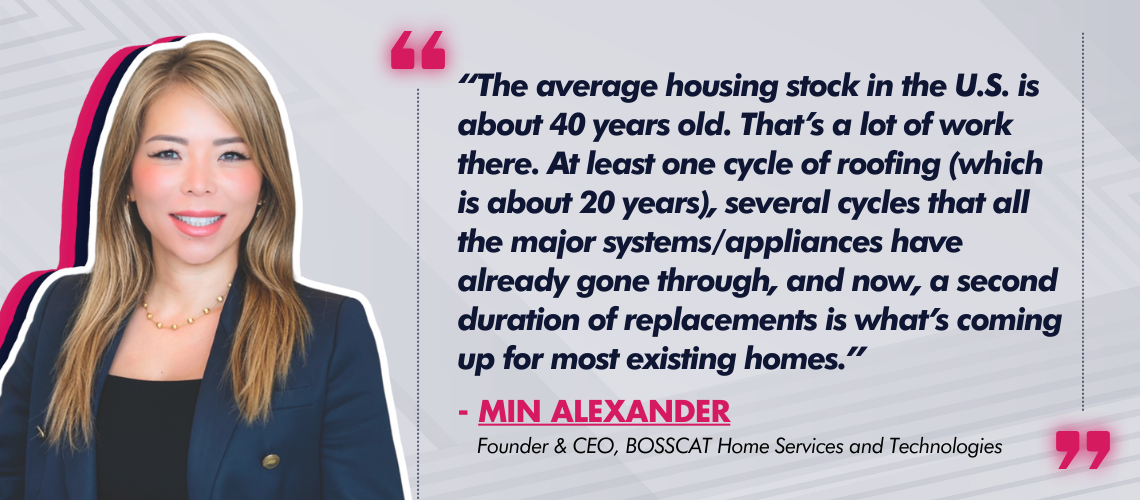Jeff Goodman, a New York-based agent with Brown Harris Stevens, explains that if a buyer isn’t ready to pay carrying costs, they’re not ready to be a homeowner. One of the most obvious is the cost to maintain the home, from foundation to ceiling.
As home prices and insurance costs have risen, how are home maintenance costs—from routine upkeep to emergency repairs—evolving? And when homebuyers think of a property they can “afford,” do they factor in those long-term costs?
Mattar says that deferred maintenance, from repairs to upgrades, are a current affordability issue for homebuyers.
“Unfortunately for buyers, we’ve been in a very seller-favorable market for many years now due (in part to) the overall sense of low inventory. And so buyers’ hands are sometimes forced in a low-inventory environment to make offers higher than they would like to pay based on the condition of the property or some of the big-ticket items (such as) window repair or failing mechanical amenities like air conditioning,” explains Mattar. “That low-inventory environment is making several buyers ‘bite the bullet’ on a property that will need renovation (perhaps in several places).
“I can think of a couple deals I’ve done where they know that if they want to buy a home, they need to budget for some of those big-ticket items that maybe in years past could have been bigger points of discussion between the buyer and the seller,” he adds.
Do buyers account for those maintenance costs when searching for a home, or not?
“It’s somewhere in the middle, but I would say most of our clients are probably more toward the end of not realizing all of the ancillary costs or all of the intricacies, which, in my opinion, is the whole reason why they hire a REALTOR® to begin with,” says Mattar. “Because people like me who have the expertise to be able to guide them and educate them, not only from the very beginning, but throughout the course of the process, is paramount for them to be able to understand those things.”

When it comes to specific education and clarity that REALTORS® can provide, Mattar says he and his team aim to conduct unofficial inspections from the very first showing.
“We’re there to begin to eyeball and identify things that might come up on the inspection report,” he says. “Obviously not everything, but things that are visible to the naked eye, whether those are hardwood floors that seem to be pretty beat up or a broken thermal seal between the double panes of the windows,” he says, adding that this makes it easier to assess the cost of the property with the client.
“I never let anyone overpay, but when you have the conversation about the things we think are going to need to be done, what price would we absolutely love to get this home for if we know that we’re taking on those things?”
While your own eyes will never deceive you, there are outside resources to get that assessment.
“Homeownership is incredibly hard,” says Min Alexander, founder and CEO of BOSSCAT Home Services and Technologies, a company that offers a data platform that calculates repair estimates and provides repair services for homeowners (and NAR members through a member benefit).
“The average homeowner today needs to spend about $6,000 a year on just basic maintenance,” adds Alexander, citing her own experience with maintenance as a homeowner and real estate investor, noting that “pricing information asymmetry” means that homeowners can find the bill on repairs or maintenance to be much higher than anticipated.
BOSSCAT, per Alexander, aims to make home assessment and client education about likely repairs easier—with the company’s repair estimate tool addressing another resource both the buyer and their agent are spending: time.
“A major pain point is when you’re making an offer on your home, you need two things that are probably the most important documents. You’ll have your appraisal, and you need your home inspection. Both are very dense, lengthy documents…(y)ou can see any excitement a homebuyer or home seller will have once you get a 50 – 60 page PDF, it’s kind of like a fizzling balloon,” says Alexander, who compares her company’s service to a line-item maintenance report where agents/buyers have to then call up tradespeople for estimate and repair services.

Alexander adds that, “A lot of homebuyers and homeowners don’t track the replacement dates of all their major systems,” which can result in higher costs if the system fails suddenly and repairing becomes an emergency.
“Almost everything in your home has an expected lifespan, and so for us, we want to share our knowledge so that homeownership becomes much calmer,” says Alexander. “You can plan things ahead of time, line up financing with good terms before you need it and it becomes an emergency.”
Alexander also points to the current age of housing stock as another reason preservation should be at the top of homeowners’ minds.
“The average housing stock in the U.S. is about 40 years old. That’s a lot of work there. At least one cycle of roofing (which is about 20 years), several cycles that all the major systems/appliances have already gone through, and now, a second duration of replacements is what’s coming up for most existing homes,” says Alexander.
Alexander’s assessment on the age of housing stock is backed by data. A recent report from the Joint Center for Housing Studies of Harvard University (JCHS) found that, as of 2023, the median age of housing stock is 44 years old. Additionally, homes built before 1980 face repair costs 24% higher than newer stock (homes built in 2010 or later).
But that’s not all. In fact, JCHS calculated that between 2022 and 2023, spending for home repairs after natural disasters jumped to $49 billion. Twenty years prior, from 2002 to 2003, spending on disaster repairs had been $16 billion.
While home damage, and needed emergency repairs, can occur gradually due to a home’s age, disaster can also strike instantly.
“Expect the unexpected” might sound cliche, but it describes the outlook homebuyers should take when it comes to extreme weather damage.
Asked about the most expensive types of home repairs, Powell cites both interior and exterior damages. While water damage and removing water from the home’s interior is costly, roof replacement (especially if lined with gutters) can cost nearly 35% as much as water damage.
Hepp says agents working in high-risk areas have been taking note and looking to preventive mitigation for home repairs. For instance, homes built in flood zones are less likely to flood if they’re built with raised foundations.
“We see homes, even during the last hurricane that came through, that were raised and were much less likely to flood,” says Hepp, “so there’s going to be that type of advice being given where it’s like, well, how can you mitigate—you can mitigate by doing this.”
Extreme costs are of course where home insurance comes back into the equation. Mattar shares a recent anecdote about completing a transaction for a house in a known flood zone.
“We proactively reached out to my preferred insurance broker who sells flood insurance and discussed it with her, gave her the property address and had her run a potential policy for (my buyer clients) to find out if it was going to be cost prohibitive because the flood insurance policy is in addition to the homeowners policy that they needed,” he says.
Should this sort of pre-assessment become more standard? Mattar maintains that he and his clients only did so because the risk of buying in a flood zone was so apparent. Alexander, though, says that due to the steady increase in disasters, homebuyers researching an area to get a better idea as to the type of damage their home may potentially incur—and how to prevent it—“is probably more important.”



